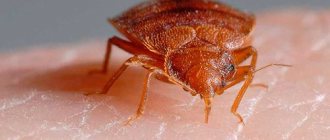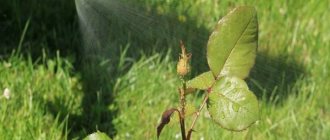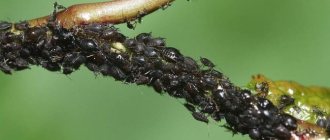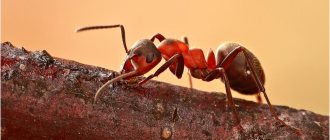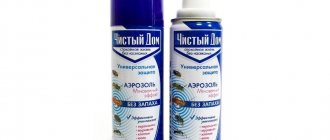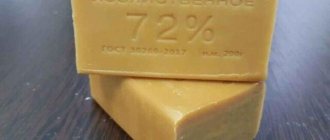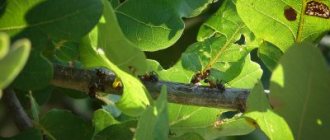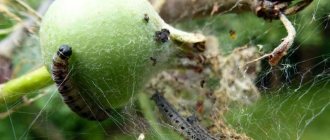There are many different traps designed to reduce garden pests. Popular adhesive trapping belts for trees largely block the pest's path to the tree crown and hold it tightly. An adhesive catch belt is a strip of fabric, paper or other material, onto the surface of which a special glue is applied that does not harden for a long time. The benefits of this remedy are obvious, but there is also “the other side of the coin.”
Glue catching belt with insect pests stuck to it
Cheap remedy
You can make this insect killer yourself without spending money on a store-bought version.
There are several types of belts. Each of them is easy to make yourself.
Dry ones are funnels made of cardboard, rubber or other material, single-sided or double-sided. In spring, the trap is set with the wide edge pointing down. The rising insects enter the funnel, but cannot move upward. In autumn, the funnel looks upward with its widened edge and catches pests descending along the trunk for pupation and wintering.
Types of glue in traps
Rat glue is made from viscous polymers that melt at temperatures below room temperature. Thanks to this property, they are easy to apply and do not harden or dry out throughout the entire period of use. The composition contains a large amount of polybutene, there are additives of cycloisan and polyisobutylene.
There are 2 types of such traps:
- Boards with glue already applied. Before use, the protective film must be removed from them. Thanks to the pleasant-smelling components, such “traps” attract mice.
- Suspension in a bottle or tube. This is a gel-like form that you need to apply to the base yourself. The cost of such funds is usually lower. Most often, the gel is applied to cardboard. Some manufacturers recommend sprinkling some grain on top.
Harmless insects die
One of the significant disadvantages is the death of harmless and beneficial insects - bumblebees, bees, ladybugs.
There were cases when small birds stuck to the thickly glued material, leaving tails or feathers from the wings. Birdies see insects and try to peck them, getting their wings stuck in the glue.
To avoid such circumstances, gardeners recommend covering the belt with an apron. A rolled sheet of cardboard or other material is secured in such a way that there is space between it and the belt for pests crawling along the trunk. Flying insects and birds will be safe.
How to remove glue - methods
Theoretically, mouse glue can end up on any surface. Pets often step into it - cats, dogs, hamsters, which stain the fur. It happens that children get into the trap and then touch furniture and other things. Glue stains can end up on your hands and clothes if you are not careful during application. Even a gadget can be damaged, fortunately, its surface has a protective oleophobic coating that repels fat and any dirt.
How to remove glue from your hands
Your hands often get dirty with the substance, but you can’t just wash it off with water or soap. An adult without allergies or skin hypersensitivity can use aggressive solvents - acetone, kerosene. You need to soak a cotton pad or a piece of cloth in the solution, apply it to the stain, then wipe it off with active movements. Afterwards wash your hands with soap. You may need to repeat the procedure 2-3 times.
It is important not to keep the cloth on the skin for long, otherwise you may get burned. If redness or irritation appears, you must immediately stop the session, wash and dry your hands well. Such methods cannot be used for children's hands! For kids, you can remove the glue mark from the skin like this:
- soak a cotton pad in any vegetable oil;
- apply to skin for 10 minutes;
- Carefully wipe off the softened glue and wash your hands.
This method is harmless, gentle, and can be repeated as many times as necessary until your hands are completely clean.
How to clean the floor
Careless handling of glue leads to its appearance on the floor. When the adhesive has hardened, the floor can be carefully cleaned with a plastic scraper or spatula. If the glue is still soft, alcohol will remove it. You need to apply a cloth moistened with alcohol to the surface and wipe off the stain after 10 minutes. This way you get rid of the glue on the linoleum.
It is better to try to wash off the glue from laminate flooring with laundry soap. The wetted floor is washed with a thick soap solution using a hard sponge, then the residue is removed with water. The method of removing adhesive with lemon juice or citric acid solution is also popular among people, but they also need to be given time to act. There are also options to carefully clean the glue with sandpaper, wipe with acetone or vegetable oil. We must remember that these measures can spoil the surface and cause unsightly stains to appear on it.
Cleaning glue from furniture
A stain on a sofa or armchair is a real problem, because it is difficult to wash the product. But it is still possible to remove the glue using carpet cleaner, washing powder, or laundry soap. Do not rub the coating too hard - white spots may appear on it due to damage to the fabric fibers. You can try to wash the glue off leather furniture with soap or wipe it off with vodka.
Alcohol is not a damaging agent for wooden surfaces; it can be used more safely. Plastic and glass furniture cannot be damaged by alcohol, as well as chipboard and fiberboard. It is undesirable to use only hard brushes, which can leave scratches. Painted and varnished elements will have to be washed with powder, soap, thorough rinsing with water and quick drying with cold air.
How to remove glue from clothes, fabric, carpets
If you use organic solvents on textiles, there is a risk of severe damage to the product. You won't be able to remove glue from clothes with oil either: it will leave a greasy stain. You can try washing it by hand several times so as not to damage the washing machine with glue. Some people use aggressive toilet cleaners and grease solvents on household items. It is better to dry clean high-quality, expensive items.
Carpets should also be taken to professionals or use special cleaning products such as “Vanish”. Unfortunately, when fibers are impregnated with glue, it is not always possible to completely remove it, especially on natural and long pile.
How to remove glue from animal fur
Pets and fur can get into the glue trap, and their feathers immediately get dirty. To remove glue from a cat, dog, or other animal, you will have to cut off a piece of hair. For this purpose, you need to invite an assistant who will hold the animal while shearing, otherwise there is a risk of injuring it. A full haircut should only be done in a pet salon.
When a cat's paws are dirty, trimming it won't help. You will have to scrub off the glue with oil, and then wash it off the fur with a special shampoo for animals. You can also use vodka or alcohol to remove glue. It is not recommended to use perfume or cologne to avoid allergies in your pet. Acetone should absolutely not be used!
When using mouse glue, you should take precautions. You need to wear gloves when setting the trap; for rats, you should very securely fasten the board to the floor. It is necessary to choose the place where rodents most often appear and immediately warn your family about the installation of a trap. It is advisable to protect the glue trap from children and pets by any convenient means.
The bark is damping off
Many gardeners try to secure the belt as tightly as possible to the trunk so that there are no gaps through which insects can crawl. However, the tight fit of the material to the tree prevents air from reaching the bark.
Damping off occurs. The bark and cambium are damaged. Plant tissues darken, crack and peel off. This results in poor tree growth. If the damage to the bark is circular, then the tree dies.
To prevent damping off, breathable burlap is placed under the synthetic material of the belt. And the belt itself is often moved to another place on the trunk.
Why do they make a tree catcher?
Hunting belts are made to prevent ants from breeding aphids, the most dangerous pest of garden plots. Being symbiotes, ants and aphids “occupy” fruit trees (apple trees, pears, plums) and berry bushes (currants, gooseberries). Numerous aphids curl leaves, destroy shoots, and significantly impair quality and yield. This ultimately leads to the death of entire branches, and ultimately the entire fruit tree.
Ants treat it with reverence and care - they actively protect, spread and even carry aphids away for the winter. Moreover, they breed it solely for pleasure, to obtain the “sweet nectar” that aphids secrete.
In addition to aphids, ants also breed copperheads, scale insects, and cicadas, i.e. those insects that secrete large quantities of honeydew - “sweet nectar”.
What pests does this device help with?
Similar mechanical traps are used against any caterpillars, especially all
varieties of codling moths, weevils, herbivorous mites, apple flower beetles, ants (red and black garden), whiteflies, aphids.
In general, trapping belts collect and trap any insects living on fruit trees.
Cleaning glue from furniture surfaces
Upholstered furniture, unfortunately, is unlikely to be saved, since you cannot simply wash part of a sofa or armchair. But if the stain doesn't look so bad, you can try carpet cleaner, stiff brushes and liquid laundry detergent.
With hard furniture surfaces the chances are much greater. If it's natural wood, don't be afraid to use alcohol - it won't harm it. The same goes for plastic and glass. With wood substitutes, as well as with any painted elements, it is better to return to lemon juice and laundry soap. The process will take longer, but the material will suffer less.
Having familiarized yourself with numerous recommendations for amateur gardeners, you can find out that in the summer and autumn periods it is necessary to carry out thorough pest control. The most dangerous of them is the codling moth, since the harm it causes is difficult to underestimate. For these purposes, various agrotechnical measures are carried out. A special place among them is the cleaning of bark from trees, but the effectiveness of this method is not sufficient to use it independently when fighting the codling moth.
Content
- Catching belts are the most effective method
- Operating principle of catch belts
- Overlay Rules
- apply after flowering
- the role of clearing trees of bark
- fixation rules
- inspection and destruction of pests
- Materials required for manufacturing
- Video production technique
- Advice from professionals
- Ecotrap fishing belt is a very effective tool
Catching belts are the most effective method
In this regard, gardeners have come to the conclusion that the most effective method of cleaning fruit trees from codling moths and mites is to use catching belts.
The principle of operation of catch belts
Hunting belts on their own do not guarantee pest control unless you use self-adhesive or pesticide-impregnated belts. The use of trapping belts involves concentrating caterpillars or other pests in a certain place, and there are cases when the number of insects caught reached more than 600 individuals. Thus, if you plan to get a high harvest, then it’s time to think about buying fishing belts or making them yourself.
Overlay Rules
Considering the above, the use of tree catching belts must be carried out in accordance with certain rules.
apply after flowering
Firstly, the application of belts on fruit trees is carried out at the end of 2-3 weeks after flowering, when there is still some time before the start of the mass season of codling moths.
the role of clearing trees of bark
Secondly, it is necessary to mention again the proven method of gardeners, which consists in clearing trees of dead bark. This procedure is carried out on the bottom of the trunk 25 cm above the soil level.
fixation rules
Thirdly, the rule for applying catcher belts states that the upper part of the belt is tightly fixed to the bark, and the lower part is left free, which increases the likelihood of caterpillars getting under it; in this case, interception of the bark must be excluded, for which it is necessary to loosen the ties every month.
inspection and destruction of pests
And finally, to increase the effectiveness of this method, inspection of hunting belts is carried out at least once every 10 days, especially during the development of codling moth caterpillars, followed by the destruction of detected pests and disinfection of the belt.
Materials required for manufacturing
Making a hunting belt with your own hands is within the power of each of us. The main material is corrugated paper or burlap. The main disadvantage of a belt made of corrugated paper is its one-time use, since the selection of pests from it is associated with certain difficulties. For repeated use, belts made from old blankets or any other fleecy fabric folded in two layers are ideal.
Manufacturing technique
The technique of making a hunting belt is not difficult.
To do this, it is enough to cut a strip, the width of which is no more than 10-20 cm, and the length is twice the girth of the tree trunk. Also, the optimal material can be newspaper or any other thick paper. Having folded it in four or five layers and made a tourniquet, it must be placed around the trunk, covered with a strip of thick paper and secured, like any other hunting belts on fruit trees. Experienced gardeners advise choosing a belt design that suits you one hundred percent. For example, for gardeners who love fishing, such a belt will be the one from which it will be most convenient to select caterpillars that will become excellent bait.
Advice from professionals
In some areas, codling moth development occurs in two generations. Gardeners whose summer cottages are located in these areas should apply belts in mid-June and check them every week until the belt is removed, which should ideally occur in mid-August.
If you follow the advice of experienced professionals, then having a double set of trapping belts greatly increases the effectiveness of this method, since in this case, when you remove one set of belts, you immediately apply a second one, having previously destroyed the pests remaining at the place where the belt is attached. If the belt is made of fabric, then processing it is not difficult: just soak it in hot water with powder, and after a few hours, use a brush to remove dirt and cocoons. After drying in the fresh air, the belt is again clean and ready for use.
Mid-August is not a reason to take off your belts. At this time, gardeners advise leaving them on the trees until late autumn, until they become full of mites. But there is a certain nuance here: the most convenient for collecting ticks will be corrugated paper belts, which are applied not only to the trunk, but also to all skeletal branches. At the end of the season, such belts are removed and buried in a compost pit.
Ecotrap fishing belt is a very effective tool
Ecotrap trapping belts are an effective means of fighting insects. They are a toxic-free adhesive that is applied in the form of trapping belts to tree trunks. The glue is applied in the spring months, shortly before insects migrate from the soil to the tree crowns. During mass migration, insect pests stick to the belt, which ensures the protection of your future harvest.
Author: Sergey and Svetlana Khudentsov
10
